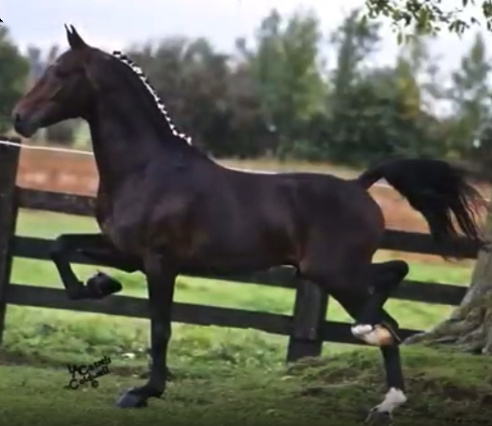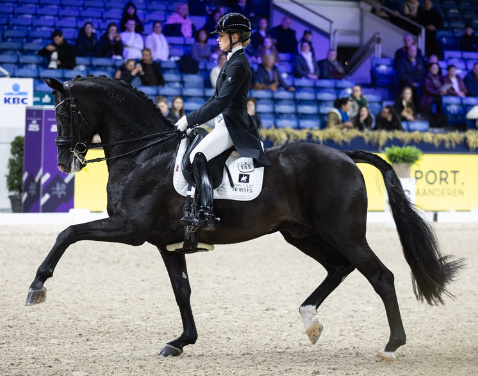Too much. Which is why she still has it.
LOLOL! We all know that! Just curious on the actual price that she won’t budge on. 
Well, for the other one she wanted mid-5s. I’m assuming it’s probably close to the same.
For that price, for her supposed ammy buyer and in the market she placed the ad, you could get one that was imported and is already under saddle and doing things with quite a bit of show record and training under it’s belt.
ETA: just saw the ad……she won’t give a price because she has no problems keeping her.
ETA: just found her old ad…she wanted 
 ,
,

 in June. In my market you can still find something already started and doing things for that price range, especially for eventing.
in June. In my market you can still find something already started and doing things for that price range, especially for eventing.
oh lord. 
In dressage and jumping horses (sport horses), the hindleg needs to come forward under the center of gravity and provide lifting (carrying) power. This is especially important as horses move up the levels / heights and the work requires more lifting power. They are also expected to demonstrate more gaits than just trot (walk-trot-canter for dressage horses, gallop for jumping horses). And they are expected to have elasticity through the body and “swing” in the topline, making them easier to sit.
OTOH, walk-canter-gallop are not particularly prized in harness horses, whose claim to fame is a fancy trot. Nor does a harness horse need to have lifting power in its trot - they are instead expected to stay “on the ground” (so to speak) and drive straight forward with a lot of knee and hock action. The hindleg contributes a bit to push but not so much to lift other than to snap the leg up in an extreme fashion - and that isn’t lifting the body and propelling it forward so much as it is just lifting the leg itself. A trailing hindleg makes that high action easier to perform and contributes to the snappiness of the gait. The level-flattish croup makes the biomechanical action of snapping the leg up quickly an easier feat as the horse isn’t wasting motion or energy placing the leg very far forward under its body - nor are they expected to “sit” like a dressage horse, or fold the hindquarters like a jumping horse, so they don’t need a slope to the croup. And since they generally aren’t ridden, they don’t need to have a supple back so they tend to be quite rigid through the topline - although it doesn’t flex, it does help stabilize the horse as it snaps its legs up.
I’m not sure I am explaining this very well but that is my understanding from speaking with someone who did fine harness for years with ASBs and Hackneys and has been considering dabbling in DHH. We have occasional (sometimes lively!) discussions about the merits of fine harness vs sport horse disciplines! 
Completely agree with this.
This is a great explainer on the differences in biomechanics. Thank you!
Interesting, thanks.
Different purposes. And yes a horse with suspension and a bouncy collected trot makes the jog cart feel like it’s about to go airborne imo. It’s so smooth sitting behind a nice harness horse/pony that pulls the cart properly.
They have to pull from the breastcollar, granted breed show carts are light, vs push from behind and leave slack on the traces.
Yes, good point about suspension! And also about pulling from the front end. Loading the forequarters lessens the demand on the hindquarters so it is easier for the hind end to get very snappy in an up-and-down motion.
Also, as @anon6923113 mentioned above, dressage horses are expected to move over their back and through their body. Not so for harness horses, though - they can go high-headed and pull from the breastcollar instead of driving from their hindleg over their back.
I don’t know if these two photos help show the differences. The first one is the DHH stallion Dondersteen mentioned above. The second photo is of the GP dressage stallion Everdale.
To my mind, I would much rather drive Dondersteen than Everdale. But I would much rather ride Everdale than Dondersteen. So as @luvmyhackney said - different purposes.
(And I would also much rather jump Everdale than Dondersteen - Everdale has power in the hind end and he can fold his hindquarters!)


Wow, being scolded and told off already in the advert before you even express interest in the horse.
Hard pass.
It looks like Dondersteen has weighted shoes on. Especially in the front and maybe behind too. That would influence his action although he is already a high stepper. I would not have to ride Everdale - I just wish I was a good enough rider to ride him. That would be enough for me.
I was wondering about weighted shoes.
The number one thing that gives me the most pause about anything coming from Dondersteen turning into a decent riding horse is his back. It doesn’t move at all as he goes trotting around on video. He doesn’t look tense to me though - actually I think he looks like a really cool performance harness horse. But… he is not moving over his back. That’s not what is going on
@luvmyhackney made a comment that really made me think about sitting in a cart behind a harness horse like this…
It’s so smooth sitting behind a nice harness horse/pony that pulls the cart properly.
I bet Dondersteen is VERY smooth at his intended job.
But to ride? I don’t know about that. And jumping? I’m not seeing it. That doesn’t mean he can’t… but… it doesn’t look like it will be natural or conventional.
But to ride? I don’t know about that. And jumping? I’m not seeing it. That doesn’t mean he can’t… but… it doesn’t look like it will be natural or conventional.
I’d love to ride the top horse more than the dressage horse. That big trot is exhilarating and makes you giggle. It’s completely different than a nice dressage horse feeling, but everyone should ride a nice saddlebred, hackney, DHH at least once before they knock the style. Different doesn’t make it wrong.
I’d love to ride the top horse more than the dressage horse. That big trot is exhilarating and makes you giggle.
When I was a teenager, I rode, as my regular lesson horse, a former international level combined driving horse. He was one of the lead horses in a 4 in hand- IIRC, a Hackney-Standardbred cross. I can personally attest to the big trot comment 
I’d love to ride the top horse more than the dressage horse. That big trot is exhilarating and makes you giggle. It’s completely different than a nice dressage horse feeling, but everyone should ride a nice saddlebred, hackney, DHH at least once before they knock the style. Different doesn’t make it wrong.
Ha, you might be right. These days I am so tight in the hips that I think it might be easier to ride that DHH. All that action is up and down and his back doesn’t move so my old stiff pelvis wouldn’t have to move either. 
And I am not sure folks are saying that kind of movement is wrong per se - it is absolutely right for a harness horse. But a horse like that would not be successful in the dressage ring - esp. at higher levels. And it would not be successful in the hunter, jumper, or eventing disciplines either - it seems to barely be able to canter, esp. when turning.
(Full disclosure - I cut my teeth riding a Saddlebred, so I know what you are saying about the trot being exhilarating.)
Exactly. It’s not about knocking the style of the harness horse. It’s just that the biomechanics are not desirable for a riding discipline.
I have only driven a 2 wheeled cart behind ponies many years ago… but in the interest of being evenhanded, I will say I would FAR prefer to try driving with a horse that moves like Dondersteen vs Everdale. And the idea of driving a horse bred for eventing… with a natural propensity for galloping and jumping ?  That sounds a bit frightening to me….
That sounds a bit frightening to me….
Riding a Standardbred at a fast trot on a trail or in a pasture is incredibly fun but, it’s not so fun in a dressage arena.
Riding a Standardbred at a fast trot on a trail or in a pasture is incredibly fun but, it’s not so fun in a dressage arena.
There is nothing quite like it! I’m fortunate to have ridden some truly amazing, well bred sport horses and yet one of my fondest riding memories comes from the day I took our STB and pointed him at a galloping tract and said “ok, show me how fast you can go”. Just – WOW. No wonder he won so many races and raced 212 times.
The only thing is - when a TB gets very fast, they get low and flat. When an STB gets very fast, it’s like being a quarter in a washing machine. 
